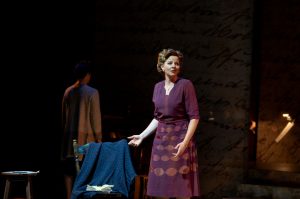
Apologies for the delayed review of New York City Opera’s world premiere of Ted Rosenthal’s Dear Erich. The sold-out performances were January 9-13, 2019 at the National Yiddish Theatre Folksbiene at The Museum of Jewish Heritage – A Living Memorial to the Holocaust. Before finally reporting on Rosenthal’s loving tribute to his father and the grandmother he never met, I wanted to visit the Museum. An opportunity presented itself with the exhibit Auschwitz. Not long ago. Not far away, on view now through January 3, 2020. Displayed are 700 artifacts and materials on loan from over 20 institutions and private collections, including the Auschwitz-Birkenau State Museum.
The Museum’ of Jewish Heritage’s Battery Park location provide glorious views of The Statue of Liberty. Her presence resonates with immigrants past and present, along with being a permanent witness to 9/11. Yet as soon as one reaches the Museum’s entrance where the improbably small German freight car representing the transport of six million souls stands, her message of hope is silenced. Inside on the Museum’s three floors, signage in English and Spanish attempts to explain the incomprehensible: the murder of 1.5 million innocent Jewish men, women and children at a concentration camp located in the small Polish town of Oświęcim. One map reveals how all Nazi train lines throughout conquered territories led to Auschwitz. Another displays the strategic locations of the five other Polish death camps (Chelmno, Belzec, Sobibor, Treblinka and Majdanek) where five million perished. Great care is taken remembering the Nazi’s long list of “inferior races” and “undesirable elements.” Among those persecuted were Roma (gypsies), Slavs, Blacks, homosexuals, the disabled, the sick, communists, political enemies, outspoken clergy, and Jehovah’s Witnesses.
A visually effective learning tool is a a white model filling a large white table showing what was behind the entrance gate’s with its slogan “Verk Macht Frei” (“Work Sets You Free”). The 15-mile death camp had three main locations: Auschwitz I, Auschwitz II – Birkenau and Auschwitz III-Monowitz. But the real story is told through personal belongings. The uncollected shoes, toys, cutlery, and clothing describe the Holocaust far better than any required reading. Quite of few have names attached to them: A photograph of Dr. Kurt Stein hangs near his suitcase.
Then, there are the physical remnants from the camp itself. Prisoner uniforms. The examination chair and instruments Nazi doctors used for their grossly unethical experiments. A shower head, tower for the deployment of Zyklon B poison and a detailed replica of a gas chamber door positioned for visitors to experience being on both sides of it. Photographs Nazi officers took of their families who lived on the grounds – and of unsuspecting prisoners before extermination.
The above paragraphs contain a lot of lists. The Nazis excelled making them. Their Final Solution is a chilling, calculated policy that left nothing to chance. Seeing this heartbreaking history up close brings with it the realization that The Final Solution was designed not to fail. The closest comparison I can think of is The Enola Gay at the Smithsonian’s Udvar-Hazy Center. That too did its job.
Survivors share their personal histories in videos and quotations on gallery walls. German Jewish refugee, New School Philosophy Professor and Holocaust scholar Hannah Arendt is prominently featured as a voice of reason. The words of Primo Levi and Elie Wiesel continue speaking for those who never could.
Herta Rosenthal wrote 200 letters to her son Erich between 1938, when he fled Germany to study at The University of Chicago, and 1941, when she was murdered at Sobibor. Erich neither discussed the letters nor Herta’s fate with his son Ted. While that might be hard to comprehend in this age of oversharing and encouragement of discussing PTSD and survivor’s guilt, those with relatives or friends who survived or fought in World War II understand that silence. After having the letters translated, Rosenthal recreated the mother/son and father/son relationships for Dear Erich.
To the frustration of his son Freddy (tenor Glenn Seven Allen) and daughter Hannah (soprano Susanne Burgess), the dying Professor Rosenthal (baritone Peter Kendall Clark) only shares his memories with his younger self (baritone Brian James Myer) and the ever-present Herta (soprano Jessica Tyler-Wright). Her letters provide the “past” narrative, an invaluable chronicle of a woman who lost everything to the world she lived – and died – in. Director Mikhaela Mahony deflty handled the two-act opera’s time shifts between Erich’s past and present.
Interspersed with these flashbacks are those of Young Erich’s new life Chicago, where he meets his future wife Lili (Rachel Zatcoff) and discovers jazz. Dear Erich is subtitled is A Jazz Opera. Rosenthal is a jazz composer who incorporated Wagnerian and military brass band themes in ugly ways illustrating Nazi thuggery.
The Professor reluctantly decides to tell Freddy and Hannah about their grandmother. Everything about Dear Erich is emotionally charged and rightfully so. But Erich’s efforts to bring Herta to America hit hardest. The American government was as bureaucratic, indifferent and Antisemitic as Germany and Vichy France. (Doris Keans Godwin’s Pulitzer-Prize winning No Ordinary Time details the Roosevelt Administration’s policy towards Jews seeking asylum and Eleanor’s reaction to it.) Fast forward to today and insert the current administration’s immigration policies and feelings about others not like themselves and not much has changed.
And still, the opera ends with pleas for remembrance and love for each other.
New York City Opera’s 35th world premiere has already been performed elsewhere and is scheduled to be again. While lacking a permanent home, the company’s reputation for singer/actors is as strong as ever.
 Sunday, December 7, 2025
Sunday, December 7, 2025